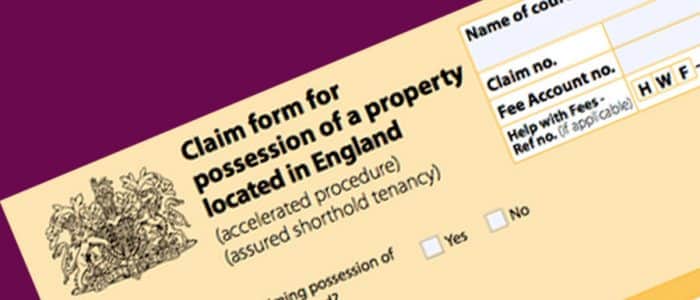How To Evict A Tenant (Residential Property)
Posted by Stephen on July 12, 2017
If as a landlord of a residential property you find yourself needing to evict a tenant, then you will already have been through a stressful period which has led up to this situation.
Evicting a tenant can be straightforward if you know what to do.
This guide sets out the procedure for evicting a tenant from residential property in England, and the related eviction laws that a landlord must be aware of. It is suitable whether the property being let is a house or a flat.
We are often asked how to evict a tenant and the process is actually quite straightforward. To evict a tenant legally, you need a court order and only court-appointed bailiffs can use physical force to remove a tenant that won’t leave a property after the court order for eviction. The Protection From Eviction Act 1977 makes it a criminal offence to evict someone without a court order.
If you are considering evicting a tenant then you will need to follow a prescribed procedure and apply to your local magistrates court (or the magistrates court nearest to where the property is located) for an order for eviction.
The exact procedure will depend on the tenancy that is in place.
In most instances for residential tenancies this will be an Assured Shorthold Tenancy. This guide focuses on how to evict a tenant that occupies the property under an assured shorthold tenancy, which is the most common type of tenancy agreement in England and Wales.
The Eviction Process
To commence regaining possession of your property and eviction of the tenant, you must first serve a notice on the tenant to terminate the tenancy.
There are two types of notice that can be used, as set out in the Housing Act 1988, and which one to use depends on whether the tenancy agreement with the tenant is still within its initial fixed term period or not.
The Tenancy is Within its Initial Fixed Term – Section 8 Notice
If the tenancy agreement is for an initial fixed term and that initial fixed term has not yet expired, then you will need to service a Section 8 Notice.
The section 8 notice can be used to evict the tenants for a range of reasons, such as non-payment of rent, anti-social behaviour or breach of other obligations contained in the tenancy agreement (such as an obligation to maintain the property in a good condition). You have to have a proper reason though.
Technically, the notice is a notice to end the tenancy for a prescribed reason (rather than an eviction notice, but that is what people commonly call it) and, if the tenants do not then leave voluntarily, a court order requiring them to vacate the property can then be applied for.
A point to bear in mind is that the amount of notice that you must give to the tenant when using a section 8 notice varies between two weeks and two months, depending on the ground you are basing the notice on (see our guide for full details).
Where The Initial Fixed Term Has Expired – Section 21 Notice (Form 6A)
If the initial fixed term of an assured shorthold tenancy agreement has expired, then you have a “statutory periodic tenancy” in place.
To terminate the statutory periodic tenancy you do not need a reason, such as breach of the tenancy agreement. After the initial term has expired, you can then serve a section 21 notice (or you can also serve a section 8 notice if you meet the requirements set out in The Housing Act 1988, e.g. where there is a breach by the tenant).
The amount of notice that you need to give to the tenant is at least two months. A key point to bear in mind is that the notice period that you give must expire on the last day of the usual rental period of the tenancy. For example, if they pay a month’s rent each month on the 13th of the month for the coming month, then the notice would be to end on the 12th of a month in at least 2 months’ time. You must state in the notice that you are giving notice in accordance with section 21 of the Housing Act 1988.
If the tenancy agreement that you are terminating was created after 1st October 2015, then there is a range of additional ‘prescribed information’ that the notice must also contain. The Government has produced a standard form template notice that they call ‘Form 6a’ that you should use for this purpose for tenancies created from 1 October 2015.
In addition, landlords in England cannot use a Section 21 notice (only for tenancies agreed from 1 October 2015) if they have not yet provided the tenant with all of the following:
- the EPC for the property (Energy Performance Certificate);
- the gas safety certificate for the property; and
- a ‘How to Rent’ guide.
‘Eviction Notices’
The section 8 and 21 notices are often referred to as ‘eviction notices’, but are actually a notice that, as landlord, you intend to take possession of the property on the expiry of the notice.
Once you have served the appropriate notice, then if the notice period set out in the notice expires and the tenant does not vacate the property, the next step is for you to commence court proceedings for a ‘Possession Order’. You cannot evict just because the notice has expired – you still need the court order.
These proceedings should be commenced in the Magistrates Court nearest to where the property is located for an Eviction Order (or online). You can commence the procedure in the court nearest to you, but the tenant will have a right to transfer it to the court nearest to them, so it is generally more straightforward (and does not waste time) to issue in the court nearest to the property in question.
Once granted by the court, the Possession Order is sent to the tenants by the court.
The court can give the tenant up to 14 days to leave the property, unless they have argued that such a short period will cause them exceptional hardship, in which case the maximum amount of time the court can give the tenant is 42 days to vacate the property.
If the tenant still does not vacate the property, then you will need to apply to the court again, this time for a ‘Warrant of Possession’. Once this is granted, a court-appointed bailiff can enter the property and (if necessary) forcibly evict the tenants.
The Eviction Procedure in Summary
- Issue a section 8 or section 21 notice (the latter is now called “form 6A”);
- On expiry of notice, if the tenant does not vacate, then issue possession proceedings for a Possession Order;
- If the tenant does not vacate of expiry of the notice period in the possession order, then apply to court for a Warrant of Possession (empowering a court-appointed bailiff to evict the tenant).
Issuing Possession Proceedings
As mentioned above, you can go to the court itself to obtain the forms to make the application for the Possession Order or you can apply online.
This link takes you to the Possession Claim Online Service run by the HM Courts and Tribunals Service. Using that service, you can complete the form required to send to the court to apply for a Possession Order.
Obtaining a Warrant of Possession
If the court has issued the Possession Order and the tenants do not vacate, then, as mentioned above, the next (and final) step is to apply for the Warrant of Possession, which, once granted, the court will instruct a court-appointed bailiff to evict the tenant.
The form is called ‘Form N325 – Request For Warrant of Possession of Land’ and a copy of the form can be downloaded on the HM Courts and Tribunals Service’s form finder website here.
The Accelerated Possession Procedure
If the fixed term of the tenancy agreement has expired and you have served a valid section 21 notice and you are not claiming rent arrears then you can use the ‘Accelerated Possession’ procedure for filing for an order for possession.
With this route to obtaining possession, the court will not hold a hearing ahead of granting the Order for Possession. Instead it will take its decision based on the papers submitted to it. There is a fee payable to HM Courts and Tribunals Service (at the time of writing it is £355), but you can ask the court, in the application form, to make the tenant pay the cost of the court claim.
If you plan to use the Accelerated Possession route, then you can make the claim online via the .Gov.uk website.
We hope that this guide to evicting tenants will save you hours hunting the internet for straightforward instructions on how to go about the process of eviction. However, this guide should not be construed as legal advice.
Whilst you should be able to complete the eviction process yourself with any court application, we recommend appointing a solicitor to complete the notices and any subsequent applications on your behalf.
You can use our Solicitor Referral service to save time on finding a suitable solicitor and get quotes within 2 working days.
Get Legal & Compliance tips straight to your inbox, free!
"*" indicates required fields



